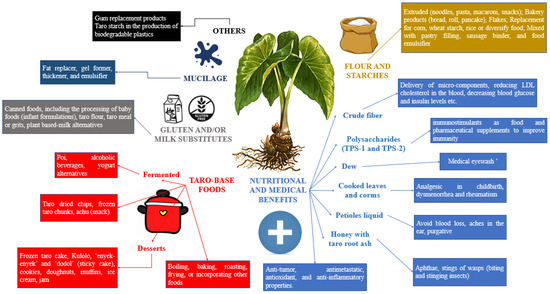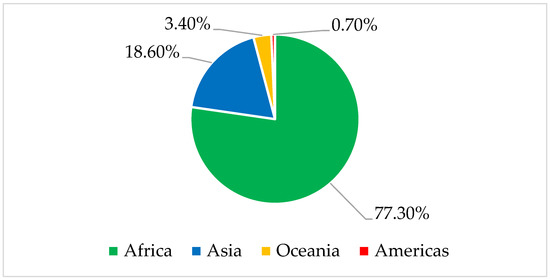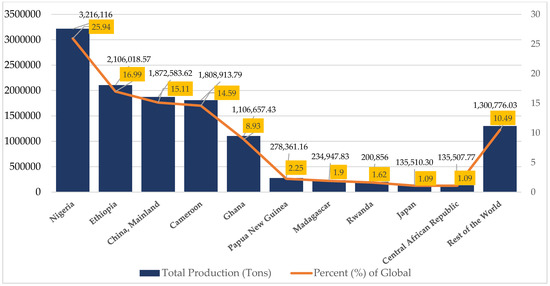Your browser does not fully support modern features. Please upgrade for a smoother experience.

Submitted Successfully!
Thank you for your contribution! You can also upload a video entry or images related to this topic.
For video creation, please contact our Academic Video Service.
| Version | Summary | Created by | Modification | Content Size | Created at | Operation |
|---|---|---|---|---|---|---|
| 1 | Ezinne Chukwu-Munse | -- | 1126 | 2023-08-06 07:53:18 | | | |
| 2 | Conner Chen | Meta information modification | 1126 | 2023-08-07 05:25:25 | | |
Video Upload Options
We provide professional Academic Video Service to translate complex research into visually appealing presentations. Would you like to try it?
Cite
If you have any further questions, please contact Encyclopedia Editorial Office.
Ferdaus, M.J.; Chukwu-Munse, E.; Foguel, A.; Da Silva, R.C. Origin and Production of Taro in the World. Encyclopedia. Available online: https://encyclopedia.pub/entry/47697 (accessed on 14 January 2026).
Ferdaus MJ, Chukwu-Munse E, Foguel A, Da Silva RC. Origin and Production of Taro in the World. Encyclopedia. Available at: https://encyclopedia.pub/entry/47697. Accessed January 14, 2026.
Ferdaus, Md. Jannatul, Ezinne Chukwu-Munse, Aline Foguel, Roberta Claro Da Silva. "Origin and Production of Taro in the World" Encyclopedia, https://encyclopedia.pub/entry/47697 (accessed January 14, 2026).
Ferdaus, M.J., Chukwu-Munse, E., Foguel, A., & Da Silva, R.C. (2023, August 06). Origin and Production of Taro in the World. In Encyclopedia. https://encyclopedia.pub/entry/47697
Ferdaus, Md. Jannatul, et al. "Origin and Production of Taro in the World." Encyclopedia. Web. 06 August, 2023.
Copy Citation
Taro (Colocasia esculenta (L.) Schott) is a tropical root crop with a rich history, which belongs to the Araceae family and encompasses over 10,000 landraces. It is cultivated worldwide in tropical and subtropical regions, including Africa, China, New Guinea, various Pacific islands, all Caribbean islands, parts of Central and South America, as well as specific regions in the United States. Recognized as one of the oldest known crops, taro is believed to have been domesticated more than 10,000 years ago.
taro roots
dietary fiber
product development
1. Introduction
Roots and tubers are recognized as substantial contributors to global carbohydrate consumption and are second only to cereals. These crops are cultivated extensively in developing nations, such that millions of farmers rely on them for food security and economic prosperity [1]. These crops are vital to income generation, sustainable development, and household food security, particularly in low-income countries. Moreover, they find versatile applications in animal feed, starch extraction, and the production of fermented foods and beverages [2]. The most world-consumed tropical roots and tubers are taro (Colocasia esculenta), yam (Dioscorea spp.), potato (Solanum tuberosum L.), sweet potato (Ipomoea batatas), cassava (Manihot esculenta), and elephant foot yams (Amorphophallus paeoniifolius). Taro holds great promise as a food and has the potential to combat malnutrition, given its underutilization thus far [3]. The taro crop has enormous potential as an economical source of dietary energy, starch, fiber, potassium, vitamin C, protein, and other micronutrients [4].
The taro plant belongs to the Araceae, which are aroids grown principally for their edible corms, petioles, and leaves. The Araceae family has 110 genera and more than 2500 species, which include Colocasia, Xanthosoma, Amorphallus, Alocasia, and Cytosperma [2]. The polymorphic species Colocasia esculenta, often known as eddo or dasheen, is cultivated for its tasty corm and is exported internationally. Colocasia esculenta (L.) Schott var. esculenta and Colocasia esculenta (L.) Schott var. antiquorum (School) are the two widely available varieties [5].
There are potentially thousands of known taro cultivars that fall into two categories: (1) the “eddoe” type (Colocasia esculenta var. antiquorum syn. Colocasia esculenta var. globulifera) and (2) the “dasheen” type (Colocasia esculenta var. esculenta) [6]. These two main varieties present different corm types; the dasheen variety is long central with few side-corms (cormels), whereas the eddoes variety shows a well-developed cormel.
Taro plants exhibit adaptability to a wide range of soil conditions, spanning from well-drained dry soils to waterlogged soils in high-rainfall areas. Optimal taro growth occurs in warm and humid environments, which is characterized by mean temperatures that range from 25 to 30 °C and well-distributed rainfall [7]. However, supplemental irrigation is occasionally necessary to ensure a successful yield. Considering the sustainability and high nutritional value of taro roots, it is worth exploring their potential to thrive in warmer regions of the USA. In addition, taro stands out as a root crop with zero waste since every part of the plant, including the leaves, peel, and root, can be utilized [8]. Nevertheless, it is unfortunate that only a limited number of studies have investigated the industrial utilization of taro as a source of ingredients for processed food products. The divisible usages of taro and its health benefits are demonstrated in Figure 1.

Figure 1. Clinical benefits and usages of taro in different food products.
2. Origin and Production in the World
Taro (Colocasia esculenta (L.) Schott) is a tropical root crop with a rich history, which belongs to the Araceae family and encompasses over 10,000 landraces. It is cultivated worldwide in tropical and subtropical regions, including Africa, China, New Guinea, various Pacific islands, all Caribbean islands, parts of Central and South America, as well as specific regions in the United States. Recognized as one of the oldest known crops, taro is believed to have been domesticated more than 10,000 years ago [9][10]. Archaeological evidence from the Solomon Islands suggests its utilization dates back nearly 28,000 years [11]. However, establishing a single center of origin for taro has proven challenging. Some theories propose South Central Asia, specifically India or Malaysia as the possible origin [12]. Matthews (1990) hypothesized an origin between Myanmar and Bangladesh in the Indo–Malayan region [13]. Nevertheless, with a comprehensive genetic analysis of cultivars or wild taro materials from these distributed regions, the precise origin of the crop remains to be determined [10].
Taro is a widely cultivated root crop in 50 countries worldwide. Nigeria is the largest producer of taro, followed by Cameroon, China, and Ghana, and collectively, they account for over half of the global taro production (Figure 1). In 2021, global taro production reached 12,396,248.5 tons, with Africa contributing 77.30% of that output. Asia contributed 18.60%, while Oceania and the Americas contributed 3.40% and 0.70%, respectively (Figure 2).

Figure 2. Production share of taro by region in 2021. Source: FAOSTAT 2023 [14].
Table 1 provides the annual taro production for various regions worldwide. In 2000, Africa was the top producer with 8,233,653.65 tons, followed by Asia with 1,930,699.73 tons. As of 2021, Africa continued to lead, producing 9,525,695.56 tons, despite a slight drop in 2010 (to 7,754,061.42 tons). The Americas had the lowest taro production from 2000 to 2021, although they experienced a substantial increase in 2015, when they produced 133,346.23 tons.
Table 1. World taro production in recent years by region.
| Year | Area Harvested (Ha) | Total Yield (Tons) | ||||||
|---|---|---|---|---|---|---|---|---|
| Africa | Asia | Oceania | Americas | Africa | Asia | Oceania | Americas | |
| 2000 | 1,250,204 | 128,872 | 44,361 | 7622 | 8,233,653.65 | 1,930,699.73 | 318,752.90 | 78,815.08 |
| 2005 | 1,383,172 | 127,935 | 55,659 | 8915 | 9,849,310.49 | 1,914,001.54 | 413,899.85 | 82,994.87 |
| 2010 | 1,194,840 | 132,284 | 52,462 | 4883 | 7,754,061.42 | 2,079,541.37 | 402,544.38 | 55,662.43 |
| 2015 | 1,575,862 | 147,251 | 48,310 | 7836 | 8,632,488.23 | 2,366,643.69 | 416,184.77 | 133,346.23 |
| 2021 | 1,590,820 | 148,515 | 48,048 | 6320 | 9,525,695.56 | 2,395,189.79 | 410,496.50 | 64,866.65 |
Source: FAOSTAT 2023 [14].
Figure 3 clearly indicates that the major share of global taro production in 2021 was dominated by 10 countries and accounted for nearly 90%. Nigeria produced the most with 25.94%, while China and Cameroon made comparable contributions of 15.11% and 14.59%, respectively. Conversely, Japan and the Central Africa Republic displayed a significantly lower contribution, each contributing a mere 1.09% to the overall global taro production.

Figure 3. Top 10 taro producers in 2021. Source: FAOSTAT 2023 [14].
Taro cultivation is typically carried out on a small scale by impoverished rural African women with limited resources. Despite being the third most important root and tuber crop after cassava and yams, taro must be utilized for export and industrial purposes, considering its nutritional benefits for health in Africa. On a global scale, the United States is the largest importer of taro, importing 35.7% of the total production in 2021 [15]. However, North America and the Asia–Pacific region are the primary suppliers of taro roots worldwide. Taro is also commercially grown in Hawaii and various parts of the Pacific Basin, although cultivation is usually limited to small plots near households. Hawaii is the largest taro producer in the US, with an estimated 4.8 million pounds of taro produced in 2021 [16]. In ancient times, Hawaiian planters cultivated around 300 taro species, often distinguished by the colors of distinct leaf portions [17]. However, taro is also grown on small-scale farms in California.
Taro can be broadly categorized into two types: upland taro, which is commonly used as a potato substitute, and wetland taro, which is primarily utilized for making poi, a fermented taro dish. While the long corms, narrow stems, and leaves of the taro plant are edible, they require thorough cooking before consumption to ensure that they are safe to eat and to enhance their taste and texture.
References
- Scott, G.J. A Review of Root, Tuber and Banana Crops in Developing Countries: Past, Present and Future. Int. J. Food Sci. Technol. 2021, 56, 1093–1114.
- Chandrasekara, A.; Josheph Kumar, T. Roots and Tuber Crops as Functional Foods: A Review on Phytochemical Constituents and Their Potential Health Benefits. Int. J. Food Sci. 2016, 2016, 3631647.
- Aditika; Kapoor, B.; Singh, S.; Kumar, P. Taro (Colocasia esculenta): Zero Wastage Orphan Food Crop for Food and Nutritional Security. S. Afr. J. Bot. 2022, 145, 157–169.
- Shah, Y.A.; Saeed, F.; Afzaal, M.; Waris, N.; Ahmad, S.; Shoukat, N.; Ateeq, H. Industrial Applications of Taro (Colocasia esculenta) as a Novel Food Ingredient: A Review. J. Food Process. Preserv. 2022, 46, e16951.
- Ahmed, I.; Lockhart, P.J.; Agoo, E.M.G.; Naing, K.W.; Nguyen, D.V.; Medhi, D.K.; Matthews, P.J. Evolutionary Origins of Taro (Colocasia esculenta) in Southeast Asia. Ecol. Evol. 2020, 10, 13530–13543.
- Okonkwo, C.A.C. Taro. In Genetic Improvement of Vegetable Crops; Elsevier: Amsterdam, The Netherlands, 1993; pp. 709–715. ISBN 978-0-08-040826-2.
- Zhang, E.; Shen, W.; Jiang, W.; Li, W.; Wan, X.; Yu, X.; Xiong, F. Research Progress on the Bulb Expansion and Starch Enrichment in Taro (Colocasia esculenta (L). Schott). PeerJ 2023, 11, e15400.
- Pereira, P.R.; Winter, H.C.; Verícimo, M.A.; Meagher, J.L.; Stuckey, J.A.; Goldstein, I.J.; Paschoalin, V.M.F.; Silva, J.T. Structural Analysis and Binding Properties of Isoforms of Tarin, the GNA-Related Lectin from Colocasia Esculenta. Biochim. Biophys. Acta BBA-Proteins Proteom. 2015, 1854, 20–30.
- Jennings, D. Tropical Root and Tuber Crops. Cassava, Sweet Potato, Yams and Aroids. By V. Lebot. Wallingford, UK: CABI (2009), Pp. 413, £37.50. ISBN 978-1-84593-424-8. Exp. Agric. 2009, 45, 382.
- Quero-Garcia, J.; Ivancic, A.; Lebot, V. Taro and Cocoyam. In Root and Tuber Crops; Bradshaw, J.E., Ed.; Springer: New York, NY, USA, 2010; pp. 149–172. ISBN 978-0-387-92764-0.
- Loy, T.H.; Spriggs, M.; Wickler, S. Direct Evidence for Human Use of Plants 28,000 Years Ago: Starch Residues on Stone Artefacts from the Northern Solomon Islands. Antiquity 1992, 66, 898–912.
- Helmkampf, M.; Wolfgruber, T.K.; Bellinger, M.R.; Paudel, R.; Kantar, M.B.; Miyasaka, S.C.; Kimball, H.L.; Brown, A.; Veillet, A.; Read, A.; et al. Phylogenetic Relationships, Breeding Implications, and Cultivation History of Hawaiian Taro (Colocasia esculenta) Through Genome-Wide SNP Genotyping. J. Hered. 2018, 109, 272–282.
- Matthews, P.J. The Origins, Dispersal and Domestication of Taro. Ph.D. Thesis, The Australian National University, Canberra, Australia, 1990; p. 421.
- FAOSTAT. FAO Statistical Database. Available online: https://www.fao.org/faostat/en/#data/QCL (accessed on 20 June 2023).
- Taro Market-Growth, Trends, COVID-19 Impact, and Forecasts (2023–2028) 2023. Available online: https://www.researchandmarkets.com/report/taro (accessed on 20 June 2023).
- Taro Statistics: State of Hawaii, 2021; Department of Agriculture, State of Hawaii: Honolulu, HI, USA, 2022.
- Whitney, L.D.; Bowers, F.A.I.; Takahashi, M. Taro Varieties in Hawaii; University of Hawaii Press: Honolulu, HI, USA, 1939; 86p.
More
Information
Subjects:
Food Science & Technology
Contributors
MDPI registered users' name will be linked to their SciProfiles pages. To register with us, please refer to https://encyclopedia.pub/register
:
View Times:
17.3K
Revisions:
2 times
(View History)
Update Date:
07 Aug 2023
Notice
You are not a member of the advisory board for this topic. If you want to update advisory board member profile, please contact office@encyclopedia.pub.
OK
Confirm
Only members of the Encyclopedia advisory board for this topic are allowed to note entries. Would you like to become an advisory board member of the Encyclopedia?
Yes
No
${ textCharacter }/${ maxCharacter }
Submit
Cancel
Back
Comments
${ item }
|
More
No more~
There is no comment~
${ textCharacter }/${ maxCharacter }
Submit
Cancel
${ selectedItem.replyTextCharacter }/${ selectedItem.replyMaxCharacter }
Submit
Cancel
Confirm
Are you sure to Delete?
Yes
No




